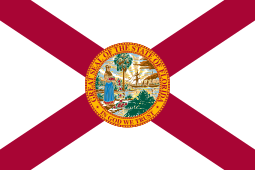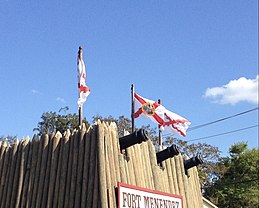Flag of Florida
 | |
| Use | State flag |
|---|---|
| Proportion | 2:3 |
| Adopted | August 6, 1868[1] (initial version) November 6, 1900[1] (first modification) May 21, 1985[1] (second modification) |
| Design | A red cross on a white field, with the state seal in the center. |
The flag of Florida is the official flag of the U.S. state of Florida. The flag consists of a red saltire on a white background, with the state seal superimposed on the center.[2] The flag's current design has been in use since May 21, 1985, after the design of the Florida state seal was graphically improved and officially sanctioned for use by state officials.
In 2001, a survey conducted by the North American Vexillological Association ranked Florida's state flag 34th in design quality of the 72 Canadian provincial, U.S. state and U.S. territorial flags ranked.[3] It is one of three U.S. state flags to feature the words "In God We Trust" (the U.S. motto since 1956), with the other two being those of Georgia and Mississippi.
History
[edit]

Spain was a dynastic union and federation of kingdoms when Juan Ponce de León claimed Florida for the Spanish Crown on April 2, 1513. Colonial authorities used several banners or standards during the first period of settlement and governance in Florida, such as the royal standard of the Crown of Castile. As with other Spanish territories, the Burgundian saltire was generally used in Florida to represent collective Spanish sovereignty between 1513 and 1821.[4]
In 1763, Spain passed control of Florida to Great Britain via the Treaty of Paris, following the latter's victory over France in the Seven Years' War, in exchange for other territory. Great Britain used the original union flag with the white diagonal stripes in Florida during this brief period. The British also divided the Florida territory into East Florida, with its capital at St. Augustine, and West Florida, with its capital at Pensacola. The border was the Apalachicola River.
Spain regained control of the Florida Provinces (las Floridas) after the Siege of Pensacola and the Treaty of Paris following the American Revolutionary War, when Britain ceded its territories east of the Mississippi River. In 1785, King Charles III chose a new naval and battle flag for Spain, which had become a more centralized nation-state, and its crown territories. This tri-band of red-gold-red was used with the Burgundian saltire in the provinces of East and West Florida until they joined the United States in 1821. Florida was admitted to the Union in 1845.
Secession from the Union
[edit]
 Flag used as a stand in for a state flag during the 1845 inauguration of Governor William Dunn Moseley
Flag used as a stand in for a state flag during the 1845 inauguration of Governor William Dunn MoseleyBetween 1821 and 1861, Florida had no official flag. The inauguration of Governor William D. Moseley in 1845 featured a flag with bars of blue, gold, red, white and green, along with the motto "Let Us Alone." However, this never was an official state flag.[5]

 Flag flown at the State Capitol on January 11, 1861, when Florida declared independence from the United States[6][7]
Flag flown at the State Capitol on January 11, 1861, when Florida declared independence from the United States[6][7]In January 1861 Florida declared that it had seceded from the Union and declared itself a "sovereign and independent nation,"[8] reaffirming the Preamble in the Constitution of 1838.[9] The state used the Naval Ensign of Texas as a provisional flag between January and September 1861.[10] It also used this flag when Floridian forces took control of U.S. forts and a Navy yard in Pensacola. Colonel William H. Chase was commander of Floridian troops, and the flag is also referred to as the Chase Flag.
Later that year, the Florida Legislature passed a law authorizing Governor Perry to design an official flag. His design was the tri-band of the Confederacy but with the blue field extending down and the new seal of Florida placed within the blue field. As a member of the Confederacy, Florida saw use of all three versions of the Confederate flag. The Bonnie Blue flag, previously the flag of the short-lived Republic of West Florida, was briefly used as an unofficial flag of the Confederacy. It features a single five-point star centered in a blue background.
Florida Constitution of 1868
[edit]Between 1868 and 1900, the flag of Florida was the state seal on a white background. In a discrepancy, however, a later version of the state seal depicts a steamboat with a white flag that includes a red saltire, similar to Florida's current flag.[citation needed] In the late 1890s, Florida governor Francis P. Fleming advocated adding a red St. Andrew's Cross so that the flag would not appear to be a white flag of truce if hanging limp on a flagpole. Floridians approved the addition of St. Andrew's Cross by popular referendum in 1900.[11] The red saltire of the Cross of Burgundy represents the cross on which St. Andrew was crucified, and the standard is frequently displayed today in Florida's historic Spanish settlements, such as St. Augustine.[12]
Historical Progression of Designs
[edit]Additional perspectives
[edit]Some historians interpret the addition of a red saltire as a commemoration of Florida's contributions to the Confederacy by Governor Francis P. Fleming, who served in the 2nd Florida Regiment, Confederate army.[13] The addition was made during a period promoting the "Lost Cause" of the antebellum South, around the time of the flag's change.[14][15] According to historian John M. Coski, the Florida legislature adopted its new flag near the time when it disenfranchised African Americans and passed new Jim Crow laws and segregation.[16] Other former Confederate slave states, such as Mississippi and Alabama, also adopted new state flags around the same time that they instituted segregation laws.[16]
Not all historians agree with assertions about association with the Confederacy.[17] James C. Clark, a lecturer in the University of Central Florida's history department, does not believe that Fleming's new flag had anything to do with the Confederacy.[17] "That St. Andrew's Cross that Fleming added, the red cross, dates back to the original flag the Spanish flew over Florida in the 16th century."[18] Similarly, Canter Brown Jr., a Florida state-educated historian who has written extensively on Florida history, says he has "seen no specific evidence linking this flag to the Confederate one."[18]
See also
[edit]- List of flags by design
- List of Florida state symbols
- List of U.S. state, district, and territorial insignia
References
[edit]- ^ a b c d e f Smith, Whitney. "flag of Florida". Encyclopædia Britannica. Retrieved December 3, 2024.
- ^ Florida Memory. "The 1868 State Flag of Florida". The State Archives of Florida. Retrieved November 26, 2019.
- ^ "2001 State/Provincial Flag Survey - NAVA.org" (PDF). nava.org.
- ^ "Florida's Historic Flags". flheritage. Archived from the original on October 6, 2014. Retrieved September 4, 2012.
- ^ "State Flag - 1845". Florida Department of State.
- ^ "Secession Flag - 1861". Florida Department of State. Retrieved January 6, 2025.
- ^ "Florida Secedes from the Union". Museum of Florida History. Retrieved January 6, 2025.
- ^ "Ordinance of Secession, 1861 (From: Florida Convention of the People, Ordinance of Secession, 1861, Series S972)". floridamemory. Archived from the original on September 20, 2012. Retrieved August 17, 2012.
- ^ "Florida Constitution of 1838". library.law.fsu.edu.
- ^ a b c Cannon, Devereaux D. Jr. (2005) [1st pub. St. Lukes Press:1988]. The Flags of the Confederacy: An Illustrated History. Cover design by Larry Pardue. Gretna: Pelican Publishing Company. pp. 36–37. ISBN 978-1-565-54109-2. OCLC 970744690.
- ^ "Florida House of Representatives - About Florida – Flags of Florida". Florida House of Representatives. Archived from the original on June 5, 2011. Retrieved November 4, 2008.
- ^ "First Muster - Florida Department of Military Affairs". Retrieved June 14, 2014.
- ^ "Florida Governor Francis Philip Fleming". National Governors Association. Archived from the original on September 18, 2017.
- ^ Williams, Dave (September 17, 2000). "Flag debate spreading across Deep South". Savannah Morning News. Archived from the original on July 22, 2015. Retrieved July 19, 2015.
- ^ Ingraham, Christopher (June 21, 2015). "How the Confederacy lives on in the flags of seven Southern states". Washington Post. Retrieved July 19, 2015.
- ^ a b Coski, John M. (2005). The Confederate Battle Flag: America's Most Embattled Emblem. United States of America: First Harvard University Press. pp. 80–81. ISBN 0-674-01983-0. Archived from the original on March 9, 2016. Retrieved March 8, 2016.
The flag changes in Mississippi, Alabama, and Florida coincided with the passage of formal Jim Crow segregation laws throughout the South. Four years before Mississippi incorporated a Confederate battle flag into its state flag, its constitutional convention passed pioneering provisions to 'reform' politics by effectively disenfranchising most African Americans.
- ^ a b Munzenreider, Kyle (June 26, 2015). "Is Florida's State Flag "the Most Overtly Racist Symbol in the United States"?". Miami New Times. Retrieved June 11, 2020.
- ^ a b Garvin, Glenn (June 24, 2015). "Historians differ on whether Florida flag echoes Confederate banner". Miami Herald. Retrieved June 11, 2020.


![January 13[10] – September 12, 1861](http://upload.wikimedia.org/wikipedia/commons/thumb/6/68/Florida_Provisional_1861.svg/200px-Florida_Provisional_1861.svg.png)
![September 13, 1861[10] – August 5, 1868](http://upload.wikimedia.org/wikipedia/commons/thumb/0/02/Flag_of_Florida_%281861%E2%80%931865%29.svg/200px-Flag_of_Florida_%281861%E2%80%931865%29.svg.png)
![August 6, 1868[1] – 1900](http://upload.wikimedia.org/wikipedia/commons/thumb/4/49/Flag_of_Florida_%281868%E2%80%931900%29.svg/180px-Flag_of_Florida_%281868%E2%80%931900%29.svg.png)

![November 6, 1900[1] – May 20, 1985](http://upload.wikimedia.org/wikipedia/commons/thumb/8/86/Flag_of_Florida_%281900%E2%80%931985%29.svg/200px-Flag_of_Florida_%281900%E2%80%931985%29.svg.png)
![May 21, 1985[1] – present](http://upload.wikimedia.org/wikipedia/commons/thumb/f/f7/Flag_of_Florida.svg/200px-Flag_of_Florida.svg.png)